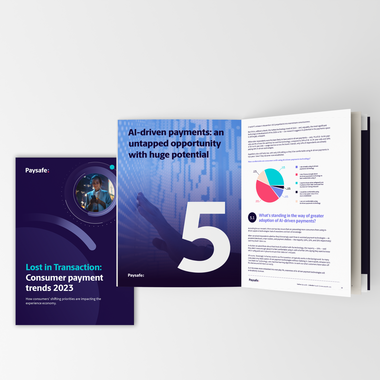
- Two minutes read
Lost in Transaction: Payment Trends 2018
Paysafe’s new Lost in Transaction report, based on 2018 research among consumers in the UK, Canada, the US, Germany, and Austria, examines the latest consumer payment trends
From stores that track the items you pick up and bill you for them transparently, to fridges that automatically re-order food items as stocks become low, advances in frictionless payments are coming thick and fast.
On the face of it, such advances seem to offer unequivocal benefits to consumers. But are consumers really ready for a world in which they abandon visibility of their financial affairs, or are they too attached to their established payment methods to make the leap and adopt new services?
Paysafe’s latest Lost in Transaction report, based on 2018 research among consumers in the UK, Canada, the US, Germany, and Austria, seeks to answer this. It looks not just at consumer willingness to adopt new frictionless models, but the attachment to existing ones; cash and online cash replacement systems, credit, contactless cards, digital and mobile wallets, and payment by invoice. It also looks at the latest fraud trends, and consumers’ attitudes to them.
Some key takeaways from the report include:
• 87% of consumers used cash to make purchases in the last month, while 83% visited ATMs. 41% of consumers are not interested in hearing about cash alternatives, a clear indication of its ongoing influence.
• The UK leads the world in contactless shopping, with 54% of consumers using it in the last month – compared to just 3% of US shoppers.
• 50% of survey respondents used a digital wallet such as Skrill or NETELLER for online purchases, more than either credit or debit cards. But in Austria and Germany, payment by invoice is more popular than card payments too, used by 38% of Austrians and 29% of Germans.
• Just 9% of consumers use mobile wallets for shopping in-store, due to a lack of awareness and scepticism about security and convenience. But usage for payments is high among smartphone owners, at 44%.
• Only 23% of consumers have used frictionless payments in apps such as Uber, despite widespread awareness. At the same time, only 18% of respondents use voice-activated payments systems.
• 43% of shoppers are comfortable using smart buttons to order often-used single items. But equal numbers would not do so, and only 33% would let fridges automatically re-order food.
• Canadian and UK shoppers reported a rise in fraud in 2017, of 7% and 6% respectively. Overall, though, consumers are making sensible choices when it comes to security, with 74% of people avoiding shopping on public or unsecured networks and 66% accepting the need for two-factor authentication systems.
Lost in Transaction: Payment Trends 2018 is available to download now.




